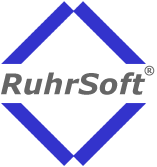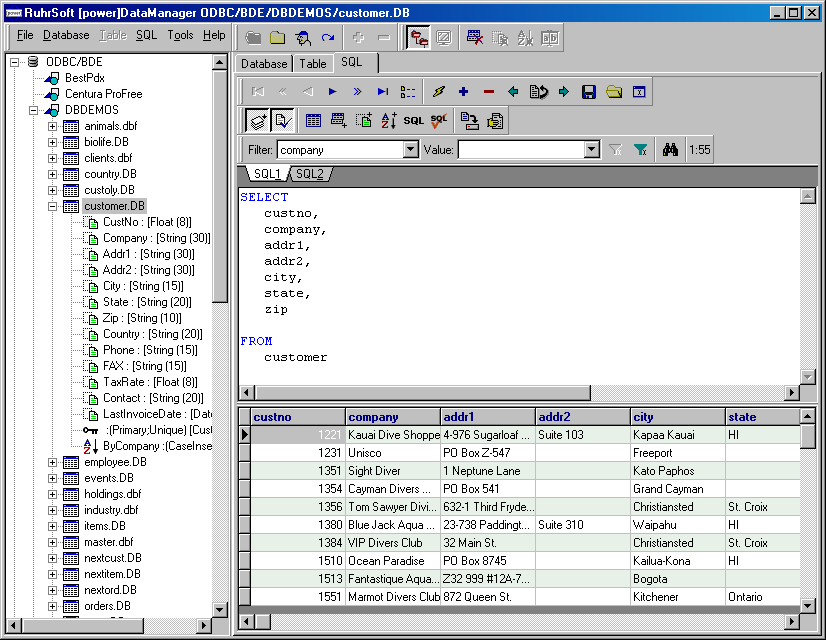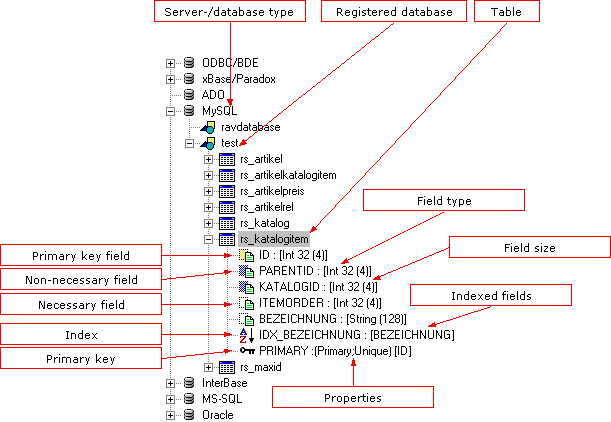
 |
[power]Datamanager 1.0.3 |
| Contents |
| 1. Overview |
| 2. Functions |
| 2.1 Database |
| 2.2 Table |
| 2.3 SQL |
| 2.4 Tools |
| 2.5 Search and Filter |
| 2.6 Further Information |
| 3. Versions |
| 4. Installation & Updates |
| 5. Information & Registration |
| 1. Overview |
[power]Datamanager is a high-performance tool for processing and administering different databases. [power]Datamanager includes the following features:
|
 |
 |
| 2. Functions |
| 2.1 Database |
Freeware Functions |
|
Standard Functions |
|
Database-Explorer |
| 2.2 Table |
Freeware Functions |
|
| 2.3 SQL |
Freeware Functions |
|
| 2.4 Tools |
Table |
|
SQL |
|
| 2.5 Search and Filter |
 |
|
| 2.6 Further Information | ||||
| SQL-Server [power]Datamanager supports in its standard version the following SQL servers: MySQL, InterBase, MS-SQL and Oracle. Access to these servers requires the client libraries necessary for the corresponding SQL server. The following server extensions are planned for in the future: PostgreSQL, DB2, SQLBase, Sybase, and Informix |
||||
| SQL-Editor Up to 9 SQL Editors can be opened parallel with the button  . Every Editor can be activated via one of the tabs SQL1 through to SQL9 or with the keyboard combinations ALT-1 through to ALT-9. . Every Editor can be activated via one of the tabs SQL1 through to SQL9 or with the keyboard combinations ALT-1 through to ALT-9.The automatic code-completion (button  ) enables a rapid and simple lay out of SQL statements. The selection of a table from the database proceeds by entering the first letter of the name of the desired table. In the selection list, the table can be selected with Return or by a double click. By entering a dot behind the name of the table, a selection list displaying the field names for the corresponding table appears, and these can in turn be selected per Return or double click. The selection list can be deactivated at all times with Esc. ) enables a rapid and simple lay out of SQL statements. The selection of a table from the database proceeds by entering the first letter of the name of the desired table. In the selection list, the table can be selected with Return or by a double click. By entering a dot behind the name of the table, a selection list displaying the field names for the corresponding table appears, and these can in turn be selected per Return or double click. The selection list can be deactivated at all times with Esc.
Via drag & drop of tables or fields from the database explorer, SELECT statements can be compiled in quick time without any tiresome key entering. Frequently used SQL commands are available through the hotkeys F2, F3, F4, F5, F6, F7, F8, F9, F11, F12 (incl. the combinations with SHIFT and CTRL). The hotkeys can be can be adjusted through the hotkey editor (Menü -> Tools -> SQL -> Hotkeys...).
|
| 3. Versions |
| Freeware The Freeware version supports the functions as described in 2.1 (except standard functions), 2.2, 2.3 and 2.5. For the purposes of evaluation, it is possible at all times to switch from the freeware version to the standard version (shareware) by activating the standard version via the menu Version -> Standard (Shareware). All further functions are activated without any running time restrictions when switching to the standard version; however, prior to every use of the standard function a notice dialogue appears and the storing of the registered SQL server is deactivated. |
| Standard (Shareware) The registered standard version supports all the functions described here without any restrictions. For evaluation purposes the standard version can be activated from the freeware version as shareware (see above). |
| Professional (Shareware) The Professional version of [power]Datamanager is expected to be available in summer/autumn 2002 and, in addition to aforementioned functions, it will offer the following features:
|
| 4. Installation & Updates |
| [power]Datamanager can be installed with or without BDE (Borland Database Engine ®). When BDE is not installed, ODBC/BDE data sources are not available. Updates and bug fixes are made available at irregular intervals as installation version and as binaries from our web site at http://www.ruhrsoft.com/download/. Installation Requirements:
|
| 5. Information & Registration |
| Information RuhrSoft Softwareentwicklung Paderborner Str. 21 44143 Dortmund, Germany Tel. 0049/231/289516, Fax 0049/231/289517 Internet http://www.ruhrsoft.com E-Mail: info@ruhrsoft.com |
| Registration Registration fee: 250 EUR Registration is possible either per Fax (0049/231/289517) or at http://www.ruhrsoft.com/download/ |